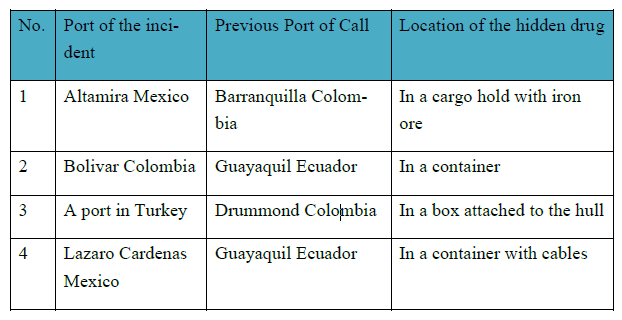LP 57/2020 Frequent Drug Smuggling via Ships in Colombia
The Club has noticed four consecutive cases in a month where authorities found drugs on ships transiting from Colombian ports to Turkey, either on board or attached to the hull. Colombia of South America with an explosion in coca cultivations has been the world’s largest producer of narcotics since 1985, and by taking advantage of ships, narcos have found ways to sneak drugs on board without being spotted by the crew.
I. Drug smuggling incidents
Here are some incidents of drug bust on ships in recent months.

Cocaine produced in Colombia are sold all over the world. Merchant ships, as a carrier with large space and no-so-unbreakable security, become an ideal tool of delivery for cartels. The small spaces in cargo holds, containers, the rudder compartment and sea chest outside the hull are common places for hiding drugs. Some smugglers may hide the drug within cargo or simply attach an iron box containing drugs to the hull through magnets. The course from Barranquilla, Colombia to Altamira, Mexico now presents the highest drug trafficking risks, while there have been several drug-related incidents on ships from Colombian and Ecuadorean ports to Turkish and Algerian ports.
II. Consequences of drugs onboard
Once drugs are found onboard and regardless of whether the crew is involved, the port State will initiate an investigation immediately and administer punishment in accordance with applicable laws – detentions in most cases and potentially fines and criminal charges on the crew. Owners and seafarers are usually the victim here.
III. Advice to Members
With reference to the information provided by local correspondent, the following measures can be taken to prevent drug smuggling.
Before entry
1. The ship should acquire up-to-date information from local agent or correspondent regarding drug smuggling risks at certain ports prior to arrival.
2. The SSO shall work actively with the CSO and PFSO to formulate a detailed risk assessment for potential security incidents.
3. In ports with increased probability of drug smuggling, owners may consider hiring additional security guards from recognized service providers.
4. The master and SSO should arrange crew training on the ISPS code, SSP, ship security obligations and port operations, highlighting the need for enhanced security while at anchor.
5. Advise the master and crew to be extra vigilant while calling at these ports and try going onshore in company in case of being used by drug traffickers.
Whilst in port or at anchor
1. Confirm with local agent on the list of ship visitors and the reasons they visit and check their identities (ID, photo, boarding pass, etc.). Unauthorized access is prohibited. An accurate record of the crew leaving and embarking the ship should also be kept and safely preserved.
2. The crew should perform regular shipboard inspections while the ship is at anchor or alongside. A 24-hour watch on shore can be practiced if shore security is hired and keep proper lighting over the deck at night.
3. Lock storerooms, accommodation area and other spaces not in use during the cargo operation. Assign men to guard the space if it is not lockable.
4. Any suspicious men or activities seen near the ship (divers or small boats) should be reported to the master, who should then report the same to the port authority. An underwater inspection is advised prior to departure (might be mandatory in sone ports).
5. If it is inevitable that ships must take bunker in such ports, masters should reach out to local agent or correspondent for an oil supplier with good reputation.
6. In some cases, stevedores or other shore-based personnel may befriend the crew to achieve their cooperation on drug smuggling. Crew should be aware of the trick and report to the master if there’s a prospective risk.
7. Even if underwater inspection is not mandatory in some ports, it is still advisable to arrange such an inspection and keep a proper record. A re-inspection will be required if the ship remain in port for over an hour after the first inspection.
Actions to be taken when drugs are found onboard
1. If illegal substances are found on board, the crew should remain calm, follow company instructions and report immediately in accordance with management practices.
2. Avoid contact with the substances and seal the area of the ship where the drugs are found. Take photos or make a video of the area as evidence.
3. Immediately advise the port authority through the vessel’s agent. Notify the company, the Club, the local P&I correspondent and the flag State authority as well.
4. The crew should be cooperative with local authorities in their investigation and obtaining evidence while the master should keep a good record of the whole process.
IV. Conclusion
Crew members and their families may be under significant stress if they got involved into a drug-related incident. Although above measures are advised to mitigate the risk, there is no guarantee that such incidents won’t happen at all. Parties including the port and the competent authority are in this together, but owners, for the benefit of themselves, are advised to do their job and see the effective implementation of these measures.
For further information, please contact your manager at the Club.
